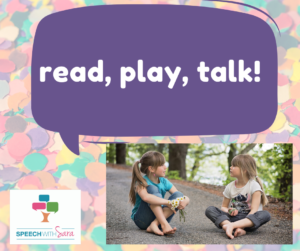 Right now, there are so many digital and online recommendations being made available. There is much generosity happening by authors, musicians, artists, museums, organizations, and the list continues. It’s wonderful.
Right now, there are so many digital and online recommendations being made available. There is much generosity happening by authors, musicians, artists, museums, organizations, and the list continues. It’s wonderful.
Honestly, though it’s also a bit over-whelming. Especially for parents who are just trying to balance work, home, children, distance- learning, extended family, mealtime, self-care and more.
As a pediatric speech-language pathologist, I want to provide some low-tech ideas of how to continue supporting your child’s speech and language skills while you’re home. These ideas involve toys, games and books you already have in your house!
- Engage in conversation. Make an effort to have face-to-face conversations with your child. Put down your smart phone, laptop or tablet, and focus whole-heartedly on the conversation. If you need, designate specifics times or places that will be technology free so conversation can happen (i.e. at mealtimes, during the evening, in the living room, etc.).
- Read with your child. Picture books are fantastic for the younger child but even older children who already know how to read benefit from reading together. Pick a book to share—read aloud or have a book club format where you designate what chapters to read and then have a discussion about during designated ‘book club’ times. If your child is working on a particular sound, emphasize it while reading; a particular language structure, talk about it when it comes up in the book.
- Play board & card games. Bust out the Uno deck, Candyland, Monopoly or Sorry games. Games often help children’s executive function skills (i.e. memory, attention, planning, inhibition, etc.). Additionally, game play involves pragmatic skills (i.e. being a modest winner, not being a sore loser, turn-taking, etc.). Games also help children target receptive language skills (i.e. following directions/ rules, executing a move/changing a plan, etc.).
- Participate in physical play. Get outside and moving around with your child. Play catch, hopscotch, or tag. Blow bubbles, build an obstacle course or have a race. Movement activates more areas of the brain and physical play is a great time to build language, participate in conversation and introduce new or different concepts. With each activity there is different vocabulary—talk about what you’re doing together.
- Talk a walk around the neighborhood and play I Spy or set to do a scavenger hunt. There are a lot of these happening right now. I currently have a dinosaur on a front window for one happening in my neighborhood! I Spy targets semantic skills as well as conversational turn-taking. Scavenger Hunts can target a lot of vocabulary about locations, categories, functions, etc. Plus, who doesn’t like to go on a scavenger hunt?
- Cook or bake together. There is so much potential language in preparing a meal or baking a treat. Vocabulary is a big one—learning all of the words related to cooking alone is nearly endless: the tools, the preparations, the styles and methods, the dos & don’ts, etc. Math vocabulary is also another big part of cooking—it’s an area in which those math skills from the classroom can cross over into real-life experience. I recently related creating equal amounts for my first grade son to measuring cups and spoons. It was nothing fancy—a scrap piece of paper where I drew the pie charts he’s been doing in math for each of the cups to build the connection between the two ideas. Cooking also targets receptive language skills such as following directions.
- Make up a story, engage in pretend play or help your child craft their own book. Any of these activities help children learn communication within social routines, story narratives, character development, and more. Follow your child’s lead with these activities and encourage them to use what’s around—so pretending a lego is a phone is absolutely fine.
- To target specific speech and language skills that are being focused on in therapy, create games. They don’t have to be complicated or even make a lot of sense, they just need to be rewarding and engaging to the child. Egg cartons, are a great example. Make an egg carton into a toss & say game, for example. Write a word or place a picture of a word targeting the speech sound your child is working on; then toss a coin in, the child practices that word so many times; then you take a turn. This is an important piece—by participating, you are modeling the correct production for your child, and you are making it more engaging! Establish a point system ahead of time and then keep track to determine the winner.
There are a few themes among all of these suggestions: engagement is first; making it fun is second; and participating is third! By doing all of those pieces, you are helping support not only maintaining your child’s speech and language skills but likely helping advance those skills too. Generally, if you are achieving all three of these themes, your child is learning regardless of what you’re doing together.
Keep in mind, you don’t have to do all of these every single day. Pick one or two that are realistic. Schedule time to make it happen. Find time when you can disconnect from work and technology—a mid-afternoon break, a pre-meeting break, etc. Lastly, tell your child about your plans for the day—include them in the plan and make it known when it’s going to happen. This helps avoid meltdowns about expectations for this time.
Speech With Sara LLC provides private speech therapy and comprehensive evaluations in the areas of speech-sound disorders, early childhood language delays, language & literacy impairments and orofacial myofunctional disorders. Have questions or want more information, please email sara@speechwithsara.com or call 313-815-7916.
